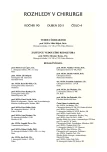Valentová-Strenáčiková S., Malina R., Selecká, P., Lehocký, J.: Changes in Alveolar Cleft Width in Children below One Year of Age with Complete Unilateral Cleft Palate and Lip
Authors:
S. Valentová-Strenáčiková; R. Malina *; Selecká; P. *; J. Lehocký
Authors‘ workplace:
Klinika plastickej estetickej a rekonštrukčnej chirurgie FNsP FDR Banská Bystrica, Slovenská republika
; Katedra biológie a ekológie, Fakulta prírodných vied, Univerzita Mateja Bela, Banská Bystrica, Slovenská republika
*
Published in:
Rozhl. Chir., 2011, roč. 90, č. 4, s. 250-253.
Category:
Monothematic special - Original
Overview
The aim of this study is to analyze the development of the anterior cleft width (G-L) in children with complete unilateral cleft. The maxillary dental casts of two groups of children were compared: a) neonatal surgical repair for clefts (16 children); b) surgical repair for clefts at the age of 3 months (7 children). The anterior cleft width (G-L) was measured before the surgical repair (after the birth in the first group or at the age of 1 month in the second group), next at the age of 3 months, at the age of 6–7 months and last at the age of 1 year. The cheiloplasty was performed by Millard and V-Y, W-Y Wardil-Kilner.
The digital slide caliper (accuracy 0.1 mm) was used for the measurement of maxillary dental casts. The “G” and “L” points were identified by Mazaheri et al. [7].
The anterior cleft width (G-L) was decreasing faster in the first group than in the second group. At the age of 3 months the G-L was 5.16 mm and 12.44 mm in the first and second group respectively. The neonatal surgical repair for clefts accelerated the decreasing of the anterior cleft width significantly. The added psychological advantage and reduction in middle ear disease [2] indicates that the neonatal surgical repair of clefts may be better than the later repair of complete unilateral clefts.
Key words:
complete unilateral cleft – dentoalveolar arch – cheiloplasty – neonatal surgical repair
Sources
1. Mcheik, N. J., Levard, G. Growth in infants in the first two years of life after neonatal repair for unilateral cleft lip and palate. Int. J. of Pediatric Otorhinolaryngolog, 2010; 74: 465–468.
2. Christie, F. B, Stirrups, D. R., Mackenzie, J. S., Lawrence, G. M. An orthodontic evaluation of 16-year-old males with an originál komplete unilateral kleft lip and palate problem repaired dutiny the neonatal period. British Journal of Plastic Surgery, 1991; 44: 557–561.
3. Millard, D. R. Cleft Craft: The Evalution of Its Surgery, Vol. 1, Boston, Little, Brown, 1976.
4. Gary, S., Bromley, M., Kenneth, O., Rothaus, M., Dicran, G., Jr. Cleft Lip, Morbidity and Mortality in Early Repair. Ann. Plast. Chir., 1983; 1: 214–217.
5. Weinfeld, A. B., Hollier, L. H., Spira, M., Stal, S. International trends in treatment of cleft lip and palate. Clin. Plast. Surg., 2005; 32: 19–23.
6. Honda, Y., Suzuki, A., Ohishi, M., Tashiro, H. Longitudinal study on the changes of maxillary arch dimension in Japanese children with cleft lip and or palate infancy to 4 years of age. Cleft Palate J., 1995; 32: 149–155.
7. Mazaheri, M., Harding, R. L., Cooper, J. A., Meier, J. A., Jones, T. S. Changes in arch form and dimensions on cleft patients. Am. J. Orthod., 1971; 60: 19–32.
8. Huang, Ch. S., Wang, W. I., Chen, Y. R., Chen, P. K. T., Noordhoff, M. S. Effects of Cheiloplasty on Maxillary Dental Arch Development in Infants with Unilateral Complete Cleft Lip and Palate. Cleft Palate-craniofacial Journal, 2002; 39: 513–516.
Labels
Surgery Orthopaedics Trauma surgeryArticle was published in
Perspectives in Surgery

2011 Issue 4
Most read in this issue
- Mytnik M., Petrík J.: Coagulation Disorder and its Uncommon Complication in a Patient with Obturating Sigmoid Carcinoma
- Sákra L., Kohoutek L., Ehler E., Košťál M., Kanta M.: Peripheral Nerve Injury during Laparoscopic Procedures
- Tomčovčík Ľ., Kitka M., Morochovič R., Burda R.: Inveterated Simultaneous Dislocation of the Proximal and Distal Radioulnar Joints without an Associated Fracture
- Tomčovčík Ľ., Rosocha L., Morochovič R., Burda R., Kitka M.: Rectovaginal Perforation in a Child
